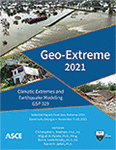Impact of Site-Specific Extreme Hydrological Cycle on Footing Performance
Publication: Geo-Extreme 2021
ABSTRACT
In this study, a new climate-adaptive design method is developed to investigate the impact of extreme climate events on the safety and serviceability performances of building footing through incorporating the site-specific hydrological loads such as precipitation, evapotranspiration, and water table depth to soil strength and stiffness parameters. The site-specific extreme hydrological cycle was determined based on historical climate records. The Richards equation was used to compute the temporal and spatial variations of the degree of saturation and matric suction considering the hydrological loads as the top and bottom boundary conditions. The proposed method was applied to a semiarid climate site in Austin, TX, as a sample application. The results show that the critical ultimate bearing capacity and settlement obtained from the proposed method are 28% higher and 35% lower, respectively, than those calculated using the conventional deterministic approaches assuming soil is fully saturated.
Get full access to this article
View all available purchase options and get full access to this chapter.
REFERENCES
AghaKouchak, A., Cheng, L., Mazdiyasni, O., and Farahmand, A. (2014). “Global Warming and Changes in Risk of Concurrent Climate Extremes: Insights from the 2014 California Drought.” Geophysical Research Letters, 41, 8847–8852.
Bowles, J. E. (1987). “Elastic foundation settlement on sand deposits.” Jour of Geo. Eng., 113(8).
Briaud, J.-L. (2013). Geotechnical Engineering: Unsaturated and Saturated Soils, Wiley, U.K.
Damberg, L., and AghaKouchak, A. (2014). “Global trends and patterns of drought from space.” Theoretical and applied climatology, 117(3-4), 441–448.
Ellithy, G. (2017). “A spreadsheet for estimating Soil Water Characteristic Curves (SWCC).”. Vicksburg, US Army Engineer Research and Development Center.
Fredlund, D. G., Rahardjo, H., and Fredlund, M. D. (2012). Unsaturated Soil Mechanics in Engineering Practice, Wiley, Chichester, U.K.
Hamon, W. R. (1961). “Estimating Potential Evapotranspiration.” Jour. of Hyd. Div., 87(3).
IPCC. (2013). Climate Change 2013: The Physical Science Basis. Cambridge University Press.
Mahmoudabadi, V., and Ravichandran, N. (2020). “Coupled Geotechnical-Climatic Design Procedure for Drilled Shaft Subjected to Axial Load” Engineering Geology, 264, 105317.
Melinda, F., Rahardjo, H., Han, K. K., and Leong, E. C. (2004). “Shear strength of compacted soil under infiltration condition.” Jour. of Geotechnical and Geoenvironmental Eng., 130(8).
Meyerhof, G. G. (1963). “Some recent research on the bearing capacity of foundations.” Canadian Geotechnical Journal, 1(1), 16–26.
Moftakhari, H. R., Salvadori, G., AghaKouchak, A., Sanders, B. F., and Matthew, R. A. (2017). “Compounding Effects of Sea Level Rise and Fluvial Flooding.” Proc of the Natl. Acad. Of Sci., 114(37), 9785–9790.
Oh, W. T., Vanapalli, S. K., and Puppala, A. J. (2009). “Semi-empirical model for the prediction of modulus of elasticity for unsaturated soils.” Canadian Geotechnical Jour., 46(8), 903–914.
Ravichandran, N., Mahmoudabadi, V., and Shrestha, S. (2017). “Analysis of the bearing capacity of a shallow foundation in unsaturated soil using monte-carlo simulation.” International Journal of Geosciences, 8(10), 1231–1250.
Richards, L. A. (1931). “Capillary conduction of liquids through porous mediums.” Physics, 1(5).
Thu, T. M., Rahardjo, H., and Leong, E. C. (2006). “Effects of hysteresis on shear strength envelopes from constant water content and consolidated drained triaxial tests.” Proc., 4th Int. Conf. of Unsaturated Soil, UNSAT 2006, Reston, Va., 1212–1222.
Vahedifard, F., and Robinson, J. D. (2016). “Unified method for estimating the ultimate bearing capacity of shallow foundation in variably saturated soils under steady flow.” Jour. of Geotechnical and Geoenvironmental Eng., doi: https://doi.org/10.1061/(ASCE)GT.1943-5606.0001445.
Vanapalli, S. K., and Mohamed, F. M. O. (2007). “Bearing capacity of model footings in unsaturated soil.” Experimental Unsaturated Soil Mechanics, 483–93.
van Genuchten, M. T. (1980). “A closed form equation for predicting the hydraulic conductivity of unsaturated soils.” Soil Science Society of America Journal, 44(5), 892–898.
Vesic, A. S. (1973). “Analysis of Ultimate Loads of Shallow Foundations.” Journal of the Soil Mechanics and Foundations Division (ASCE), 99(SM1), 45–73.
Vicente-Serrano, S. M., Beguería, S., and López-Moreno, J. I. (2010). “A Multi-scalar drought index sensitive to global warming: The Standardized Precipitation Evapotranspiration Index – SPEI.” Journal of Climate, 23(7), 1696–1718.
Information & Authors
Information
Published In
Copyright
© 2021 American Society of Civil Engineers.
History
Published online: Nov 4, 2021
Authors
Metrics & Citations
Metrics
Citations
Download citation
If you have the appropriate software installed, you can download article citation data to the citation manager of your choice. Simply select your manager software from the list below and click Download.
